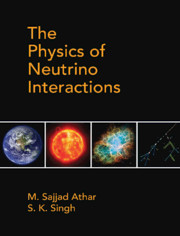Book contents
- Frontmatter
- Dedication
- Contents
- List of Figures
- List of Tables
- Preface
- Acknowledgments
- Chapter 1 Neutrino Properties and Its Interactions
- Chapter 2 Relativistic Particles and Neutrinos
- Chapter 3 Quantization of Free Particle Fields
- Chapter 4 Interacting Fields and Relativistic Perturbation Theory
- Chapter 5 Phenomenological Theory I: Nuclear β-decays and Weak Interaction of Leptons
- Chapter 6 Phenomenological Theory II: Weak Decays of Hadrons
- Chapter 7 Gauge Field Theories and Fundamental Interactions
- Chapter 8 Unified Theory of Electroweak Interactions
- Chapter 9 Neutrino and Electron Scattering from Point Particles
- Chapter 10 Neutrino scattering Cross Sections from Hadrons: Quasielastic Scattering
- Chapter 11 Neutrino Scattering from Hadrons: Inelastic Scattering (I)
- Chapter 12 Neutrino Scattering from Hadrons: Inelastic Scattering (II)
- Chapter 13 Neutrino Scattering from Hadrons: Deep Inelastic Scattering
- Chapter 14 Weak Quasielastic v(⊽)-nucleus Scattering
- Chapter 15 Inelastic Scattering of (Anti)neutrinos from Nuclei
- Chapter 16 Deep Inelastic Scattering of (Anti)neutrinos from Nuclei
- Chapter 17 Neutrino Sources and Detection of Neutrinos
- Chapter 18 Neutrino Mixing and Oscillations
- Chapter 19 Neutrino Astrophysics and the Synthesis of Elements
- Chapter 20 Neutrino Interactions Beyond the Standard Model
- Appendices
- Appendix A Lorentz Transformation and Covariance of the Dirac Equation
- Appendix B Cabibbo Theory
- Appendix C Some Properties of Pauli and Dirac Matrices and Spin Density Matrices
- Appendix D Leptonic and Hadronic Tensors
- Appendix E General Expression for the Total Scattering Cross Section and Decay Rates
- Appendix F Expressions of N(q2), the Coefficients of the Polarization Observables
- References
- Index
Appendix B - Cabibbo Theory
Published online by Cambridge University Press: 22 May 2020
- Frontmatter
- Dedication
- Contents
- List of Figures
- List of Tables
- Preface
- Acknowledgments
- Chapter 1 Neutrino Properties and Its Interactions
- Chapter 2 Relativistic Particles and Neutrinos
- Chapter 3 Quantization of Free Particle Fields
- Chapter 4 Interacting Fields and Relativistic Perturbation Theory
- Chapter 5 Phenomenological Theory I: Nuclear β-decays and Weak Interaction of Leptons
- Chapter 6 Phenomenological Theory II: Weak Decays of Hadrons
- Chapter 7 Gauge Field Theories and Fundamental Interactions
- Chapter 8 Unified Theory of Electroweak Interactions
- Chapter 9 Neutrino and Electron Scattering from Point Particles
- Chapter 10 Neutrino scattering Cross Sections from Hadrons: Quasielastic Scattering
- Chapter 11 Neutrino Scattering from Hadrons: Inelastic Scattering (I)
- Chapter 12 Neutrino Scattering from Hadrons: Inelastic Scattering (II)
- Chapter 13 Neutrino Scattering from Hadrons: Deep Inelastic Scattering
- Chapter 14 Weak Quasielastic v(⊽)-nucleus Scattering
- Chapter 15 Inelastic Scattering of (Anti)neutrinos from Nuclei
- Chapter 16 Deep Inelastic Scattering of (Anti)neutrinos from Nuclei
- Chapter 17 Neutrino Sources and Detection of Neutrinos
- Chapter 18 Neutrino Mixing and Oscillations
- Chapter 19 Neutrino Astrophysics and the Synthesis of Elements
- Chapter 20 Neutrino Interactions Beyond the Standard Model
- Appendices
- Appendix A Lorentz Transformation and Covariance of the Dirac Equation
- Appendix B Cabibbo Theory
- Appendix C Some Properties of Pauli and Dirac Matrices and Spin Density Matrices
- Appendix D Leptonic and Hadronic Tensors
- Appendix E General Expression for the Total Scattering Cross Section and Decay Rates
- Appendix F Expressions of N(q2), the Coefficients of the Polarization Observables
- References
- Index
Summary
Cabibbo Theory, SU(3) Symmetry, and Weak N–Y Transition FormFactors
For the ∆S = 0 processes,
and for the |∆S| = 1 processes,
the matrix elements of the vector (Vμ) andthe axial vector (Aμ) currents between anucleon or a hyperon and a nucleon N = n,p are written as:
and
where and are the masses of the nucleon and hyperon, respectively. and arethe vector, weak magnetic and induced scalar N − Ytransition form factors and and are the axial vector, induced tensor (orweak electric), and induced pseudoscalar form factors, respectively.
In the Cabibbo theory, the weak vector(Vμ) and the axial vector(Aμ) currents corresponding tothe ∆S = 0 and ∆S = 1hadronic currents whose matrix elements are defined between the states areassumed to belong to the octet representation of SU(3).
Accordingly, they are defined as:
Where are the generators of flavor SU(3) and is are the well-knownGell–Mann matrices written as
The generators obey the following algebra of SU(3) generators
are the structure constants, and are antisymmetric and symmetric,
respectively, under the interchange of any two indices. These are obtainedusing the λi given in Eq. (B.9) and have beentabulated in Table B.1.
From the property of the SU(3) group, it follows that there are threecorresponding SU(2) subgroups of SU(3) which must be invariant under theinterchange of quark pairs ud, ds, andus respectively, if the group is invariant under theinterchange of u, d, ands quarks. Each of these SU(2) subgroups has raising andlowering operators. One of them is SU(2)I , generated bythe generators (λ1,λ2,λ3) to be identified with the isospinoperators (I1, I2,I3) in the isospin space. For example,I± of isospin space is givenby
The other two are defined as SU(2)U and SU(2)V generated by the generators ,respectively, in the U-spin and V-spin space with (d s) and(u s) forming the basic doublet representation ofSU(2)U and SU(2)V .
- Type
- Chapter
- Information
- The Physics of Neutrino Interactions , pp. 807 - 818Publisher: Cambridge University PressPrint publication year: 2020



